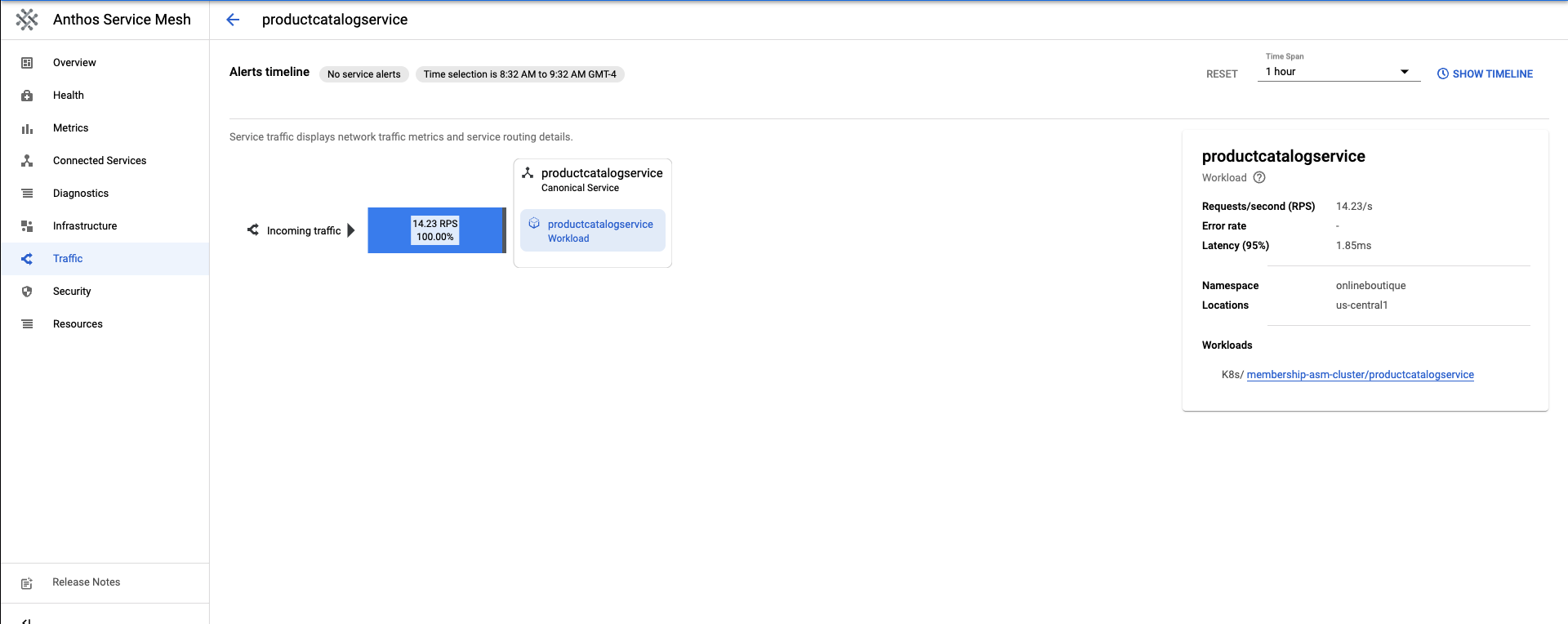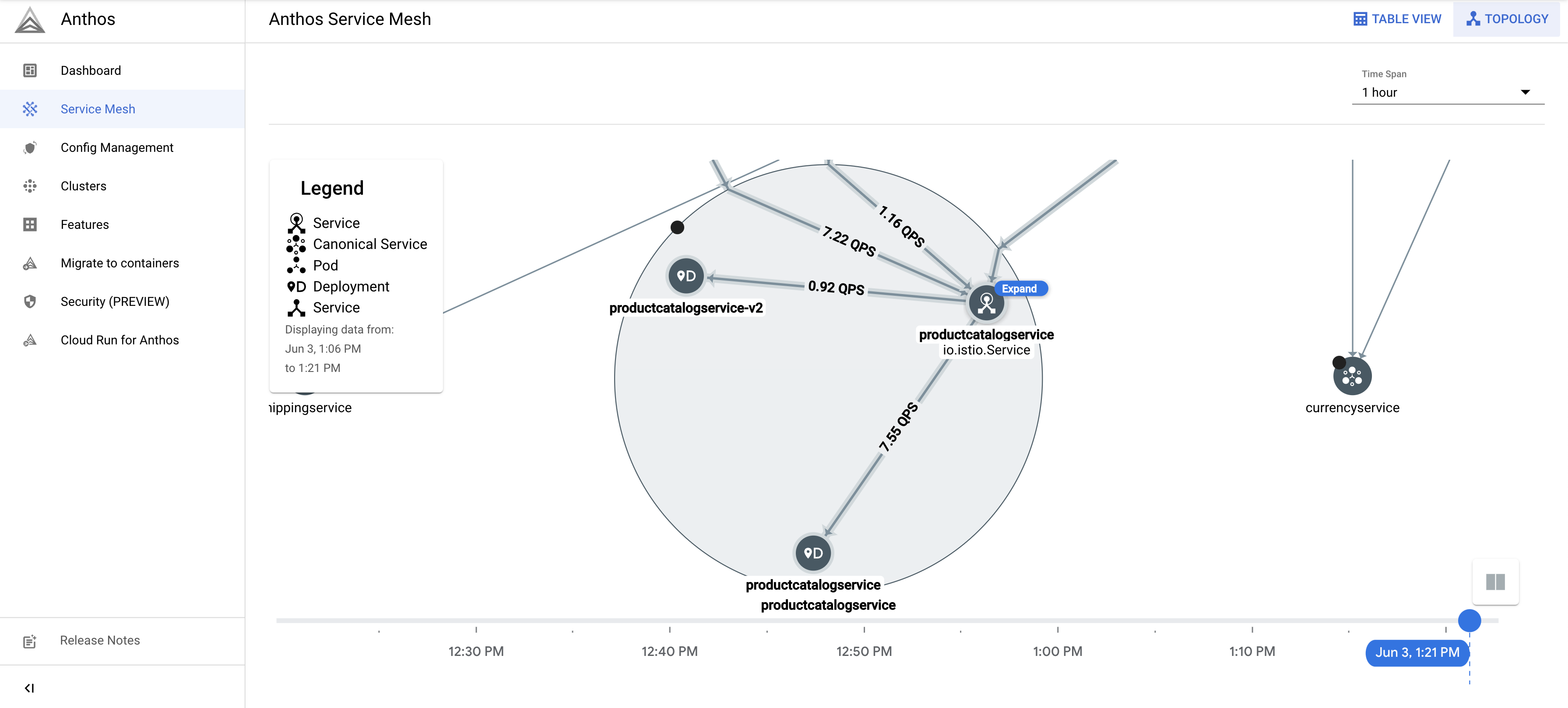In this tutorial, you will walk through a common use case of rolling out a canary deployment with Cloud Service Mesh.
What is a canary deployment?
A canary deployment routes a small percentage of traffic to a new version of a microservice, then allows you to gradually roll out to the whole user base, while phasing out and retiring the old version. If something goes wrong during this process, traffic can be switched back to the old version. With Cloud Service Mesh, you can route traffic to ensure that new services are introduced safely.
Costs
In this document, you use the following billable components of Google Cloud:
To generate a cost estimate based on your projected usage,
use the pricing calculator.
When you finish this tutorial, you can avoid ongoing costs by deleting the resources you created. For more information, see Clean up.
Before you begin
Make sure that billing is enabled for your Cloud project. Learn how to confirm that billing is enabled for your project.
Install managed Cloud Service Mesh* on a GKE cluster.
Clone the repo:
git clone https://github.com/GoogleCloudPlatform/anthos-service-mesh-samples cd anthos-service-mesh-samples/docs/canary-service
Deploy Online Boutique
Set the current context for
kubectlto the cluster where you deployed Online Boutique:gcloud container clusters get-credentials CLUSTER_NAME \ --project=PROJECT_ID \ --zone=CLUSTER_LOCATIONCreate the namespace for the sample application and the ingress gateway:
kubectl create namespace onlineboutiqueLabel the
onlineboutiquenamespace to automatically inject Envoy proxies. Follow the steps on how to enable automatic sidecar injection.Deploy the sample app. For this tutorial, you will deploy Online Boutique, a microservice demo app.
kubectl apply \ -n onlineboutique \ -f https://raw.githubusercontent.com/GoogleCloudPlatform/anthos-service-mesh-samples/main/docs/shared/online-boutique/kubernetes-manifests.yamlAdd a label
version=v1to theproductcatalogdeployment by running the following command:kubectl patch deployments/productcatalogservice -p '{"spec":{"template":{"metadata":{"labels":{"version":"v1"}}}}}' \ -n onlineboutiqueView your services you have deployed:
kubectl get pods -n onlineboutiqueExpected output:
NAME READY STATUS RESTARTS AGE adservice-85598d856b-m84m6 2/2 Running 0 2m7s cartservice-c77f6b866-m67vd 2/2 Running 0 2m8s checkoutservice-654c47f4b6-hqtqr 2/2 Running 0 2m10s currencyservice-59bc889674-jhk8z 2/2 Running 0 2m8s emailservice-5b9fff7cb8-8nqwz 2/2 Running 0 2m10s frontend-77b88cc7cb-mr4rp 2/2 Running 0 2m9s loadgenerator-6958f5bc8b-55q7w 2/2 Running 0 2m8s paymentservice-68dd9755bb-2jmb7 2/2 Running 0 2m9s productcatalogservice-84f95c95ff-c5kl6 2/2 Running 0 114s recommendationservice-64dc9dfbc8-xfs2t 2/2 Running 0 2m9s redis-cart-5b569cd47-cc2qd 2/2 Running 0 2m7s shippingservice-5488d5b6cb-lfhtt 2/2 Running 0 2m7sAll of the pods for your application should be up and running, with a
2/2in theREADYcolumn. This indicates that the pods have an Envoy sidecar proxy injected successfully.Deploy your
VirtualServiceandDestinationRulefor v1 ofproductcatalog:kubectl apply -f destination-vs-v1.yaml -n onlineboutiqueNote that only
v1is present in the resources.Visit the application in your browser using the external IP address of your ingress:
kubectl get services -n GATEWAY_NAMESPACE
This next section will tour the Cloud Service Mesh UI and show how you can view your metrics.
Deploy and View your services in Google Cloud console
In Google Cloud console, go the GKE Enterprise Services page.
By default, you view your services in the Table view.
The Table Overview lets you observe all your services, as well as important metrics at a glance.

In the top right, click on Topology. Here you can view your services and their interaction with each other.
You can expand services and view the requests per second for each of your services by hovering over on them with your cursor.

Navigate back to the Table View.
In the Services Table, select
productcatalogservice. This will take you to an overview of your service.On the left side of the screen, click Traffic.
Ensure 100% of the incoming traffic to
productcatalogservicegoes to the workload service.
The next section will go through creating a v2 of the productcatalog service.
Deploy v2 of a service
For this tutorial,
productcatalogservice-v2will introduce a 3-second latency into requests with theEXTRA_LATENCYfield.Apply this resource to the
onlineboutiquenamespace.kubectl apply -f productcatalog-v2.yaml -n onlineboutiqueCheck on your application pods.
kubectl get pods -n onlineboutiqueExpected output:
NAME READY STATUS RESTARTS AGE adservice-85598d856b-8wqfd 2/2 Running 0 25h cartservice-c77f6b866-7jwcr 2/2 Running 0 25h checkoutservice-654c47f4b6-n8c6x 2/2 Running 0 25h currencyservice-59bc889674-l5xw2 2/2 Running 0 25h emailservice-5b9fff7cb8-jjr89 2/2 Running 0 25h frontend-77b88cc7cb-bwtk4 2/2 Running 0 25h loadgenerator-6958f5bc8b-lqmnw 2/2 Running 0 25h paymentservice-68dd9755bb-dckrj 2/2 Running 0 25h productcatalogservice-84f95c95ff-ddhjv 2/2 Running 0 25h productcatalogservice-v2-6df4cf5475-9lwjb 2/2 Running 0 8s recommendationservice-64dc9dfbc8-7s7cx 2/2 Running 0 25h redis-cart-5b569cd47-vw7lw 2/2 Running 0 25h shippingservice-5488d5b6cb-dj5gd 2/2 Running 0 25hNote that there are now two
productcatalogserviceslisted.The
DestinationRuleis how to specify the subsets of a service. In this scenario, there is a subset for v1 and for v2 ofproductcatalogservice.Note the
labelsfield. The versions ofproductcatalogserviceare distinguished after the traffic is routed by theVirtualService.Apply the
DestinationRule:kubectl apply -f destination-v1-v2.yaml -n onlineboutique
Split Traffic between v1 and v2
A
VirtualServiceis how you introduce a small percentage of the traffic to direct to v2 of theproductcatalogservice.The subset field indicates the version, and the weight field indicates the percentage split of traffic. 75% of traffic will go to v1 of productcatalog, and 25% will go to v2.
Apply the
VirtualService:kubectl apply -f vs-split-traffic.yaml -n onlineboutique
If you visit the EXTERNAL_IP of the cluster's ingress, you should notice that periodically, the frontend is slower to load.
In the next section, you will explore the traffic split in GKE Enterprise Google Cloud console.
Observe the Traffic Split in Google Cloud console
Return to Google Cloud console and go to GKE Enterprise Services page Go to GKE Enterprise Services
In the top right, click on Topology.
Expand the
productcatalogserviceworkload. You will seeproductcatalogserviceandproductcatalogservice-v2deployments.
Return to the Table View. Click
productcatalogservicein the Services Table. Return to Traffic on the left navigation bar.Note that the incoming traffic is split between v1 and v2 by the percentage specified in the
VirtualServicefile, and that there are 2 workloads of the productcatalog service.On the right side of the screen, you will see Requests, Error Rate, and Latency Metrics. With Cloud Service Mesh, each service will have these metrics outlined to provide you the observability.

Rollout or Rollback to a version
After observing the metrics during a canary deployment, you can rollout to the new service, or rollback to the old service by leveraging the VirtualService resource.
Rollout
Once you are satisfied with the behavior of a v2 service, incrementally increase the behavior of traffic to the v2 service. Eventually, traffic can be directed 100% to the new service.
To direct all the traffic to v2 of productcatalogservice:
kubectl apply -f vs-v2.yaml -n onlineboutique
Rollback
If you need to roll back to the v1 service, simply apply the destination-vs-v1.yaml from earlier. This will direct traffic only to v1 of productcatalogservice.
To direct all the traffic to v1 of productcatalogservice:
kubectl apply -f vs-v1.yaml -n onlineboutique
Clean up
To avoid incurring charges to your Google Cloud account for the resources used in this tutorial, either delete the project that contains the resources, or keep the project and delete the individual resources.
To avoid incurring continuing charges to your Google Cloud account for the resources used in this tutorial, you can either delete the project or delete the individual resources.
Delete the project
In Cloud Shell, delete the project:
gcloud projects delete PROJECT_ID
Delete the resources
If you want to prevent additional charges, delete the cluster:
gcloud container clusters delete CLUSTER_NAME \ --project=PROJECT_ID \ --zone=CLUSTER_LOCATIONIf you want to keep your cluster and remove the Online Boutique sample:
Delete the application namespaces:
kubectl delete -f namespace onlineboutiqueExpected output:
namespace "onlineboutique" deletedDelete the service entries:
kubectl delete -f https://raw.githubusercontent.com/GoogleCloudPlatform/microservices-demo/main/istio-manifests/frontend.yaml -n onlineboutique kubectl delete -f https://raw.githubusercontent.com/GoogleCloudPlatform/microservices-demo/main/istio-manifests/frontend-gateway.yaml -n onlineboutiqueExpected output:
serviceentry.networking.istio.io "allow-egress-googleapis" deleted serviceentry.networking.istio.io "allow-egress-google-metadata" deleted
What's next
- For a general guide on configuring
PeerAuthenticationpolicies, see Configuring transport security.
